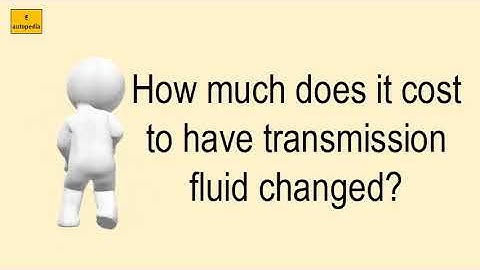Most people know about fluids like motor oil and windshield washer solution and regularly check and replace them. But other fluids, such as brake fluid and (especially) transmission fluid fly under the radar. That’s a shame: Other than the engine, the transmission is the most vital component to the vehicle’s operation. If you don’t know how often to change transmission fluid or how to check it, read on for a rundown. Show
Many car owners don’t know how often to change transmission fluid, and the truth is that there’s no hard-and-fast answer. Different manufacturers use different formulations, and their maintenance intervals for how often you should change transmission fluid can vary from about 30,000 miles to… never. Some automakers have even introduced sealed automatic transmissions with no dipstick, no filler tube and lifetime transmission fluid. There are a lot of reasons for that variance. Is there a difference between manuals and automatics?Manual transmissions need their gear oil changed over a vehicle’s life cycle, but they require a completely different type of oil from the kind used for automatic transmissions. A manual transmission’s design is fundamentally different, but their oil can still be prone to contamination by microscopic metal fragments that wear synchronizers, bearings and other parts. Manual transmissions should generally have their gear oil changed every 30,000-60,000 miles. What is automatic transmission fluid?Automatic transmission fluid (ATF) is as vital to your transmission as motor oil is to your engine. It lubricates and cools the transmission and prevents oxidation and corrosion, as well as transferring torque through the unit. Until the 1970s, transmission fluid actually contained whale oil as one of its ingredients. ATF contains additive packages, friction modifiers, anti-foaming additives, gasket conditioners, anti-corrosion agents, detergents and other ingredients custom-formulated to provide the best protection and reliability. Unlike green antifreeze or honey-colored motor oil, ATF is dyed red to make it easy to identify. Without the fluid, your car’s transmission would overheat and self-destruct within a few minutes of operation. Types of transmission fluidThere used to be only a few types of transmission fluid on the market: Type F for Ford vehicles, Type A, Dexron/Mercon for General Motors and Dexron II for GM and Chrysler models. Today, manufacturers and engineering teams have ATF formulations specific to their vehicles, including:
No doubt this seems pretty confusing, but here’s the one thing you need to remember: Each of the variations listed above are designed specifically for those vehicles. Using the wrong variety of ATF in your transmission can cause serious damage or even destroy the unit in fairly short order. Make certain that you’re using the manufacturer’s recommended fluid—even if you take your vehicle to a shop for a flush and refill. Why does transmission fluid need to be changed?Motor oil degrades over time, picking up contaminants and losing its ability to lubricate. The same sort of thing happens with transmission fluid—it picks up microscopic metal shavings, some of which are caught in the filter, then loses its lubricating properties and leaves varnish-like deposits on internal assemblies, possibly clogging small passages inside the unit. Heat in particular is the enemy of transmission fluid. The excess heat generated by towing a trailer or hauling a heavy load puts a huge amount of stress on your transmission and ATF, and will break the fluid down much faster. That’s why aftermarket transmission coolers are available for heavy hauling or towing. A transmission cooler looks like a small radiator and mounts up front for air flow, with a supply line and return line from the transmission circulating fluid through it. Signs you need to change your transmission fluidRegardless of manufacturer recommendations on how often you should change your transmission fluid, these are all signs of possible trouble:
Some of these conditions can be the result of low transmission fluid levels. Burnt transmission fluid means you should get to a transmission shop for a flush and fluid and filter change as soon as possible. Average cost to change transmission fluidBelow are the cost ranges for a transmission fluid change for popular makes and models. In general there’s little variation across models under a given manufacturer. In other words, the make of your vehicle is a greater cost determinant than vehicle type, size or trim level.
How to make your transmission fluid last longerYou still need to have your fluid and filter changed at recommended intervals, which can vary by year, make and model according to manufacturer designs. To try and get more life out of your transmission:
The transmission is the single most complex part of your vehicle—and one of the biggest expenses should something go wrong. The good news is with the right driving habits and the right maintenance, your automatic transmission should last through the entire life of your car or truck.
How long should transmission fluid last?Your transmission fluid can be in service for 10 years or longer if the car is hardly ever driven. Continuously variable transmissions, or CVTs, are another animal altogether. They are unlike any other type of transmission.
What are the signs of low transmission fluid?In the meantime, it's a good idea to familiarize yourself with the tell-tale signs that you may be low on transmission fluid.. Noises. ... . Burning Smell. ... . Transmission Leaks. ... . Slipping Gears. ... . Slow Gear Engagement. ... . Vehicle Accelerates Poorly. ... . Check Engine or Transmission Warning Light Is On.. How does a car act when it needs transmission fluid?Not being able to shift is a direct result of having low transmission fluid. Slipping Gears - On the flipside, slipping out of gear is another side effect of having low transmission fluid. For example, you may be maintaining your current speed, then suddenly feel your vehicle downshift or shift to a higher gear.
How do you know when the transmission is full?Observe markings at end of dipstick. Your dipstick might have two markings for "full"—one warm, one cold. If the automatic transmission fluid level does not come up to the "warm" line, you'll need to add automatic transmission fluid.
|

Related Posts
Advertising
LATEST NEWS
Advertising
Populer
Advertising
About

Copyright © 2024 en.ketajaman Inc.


















